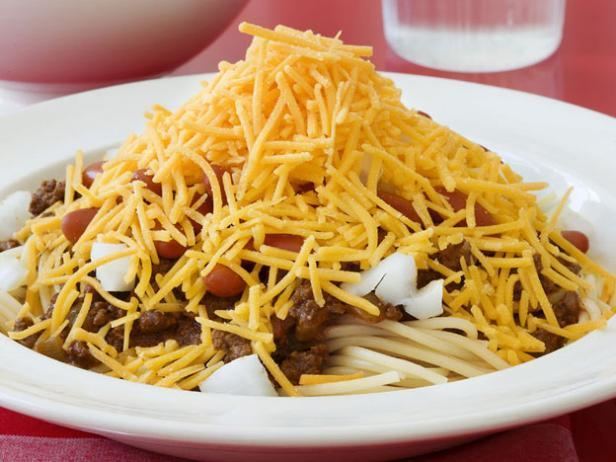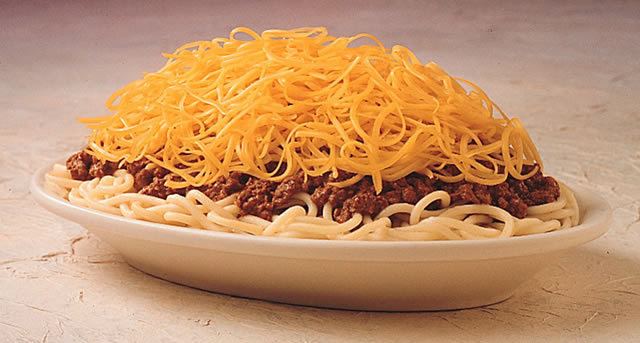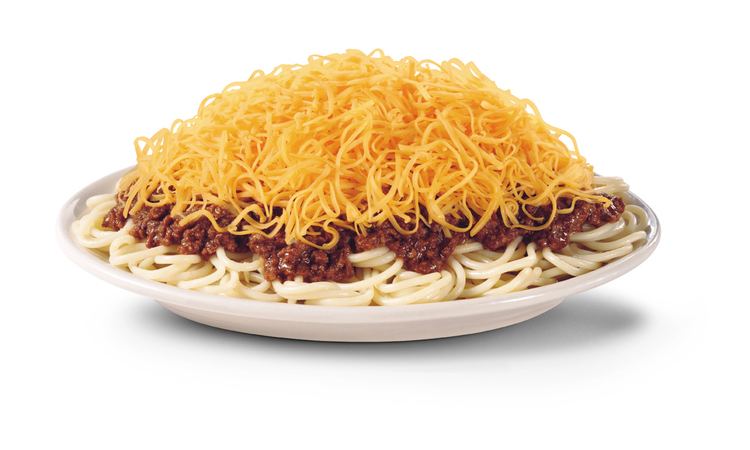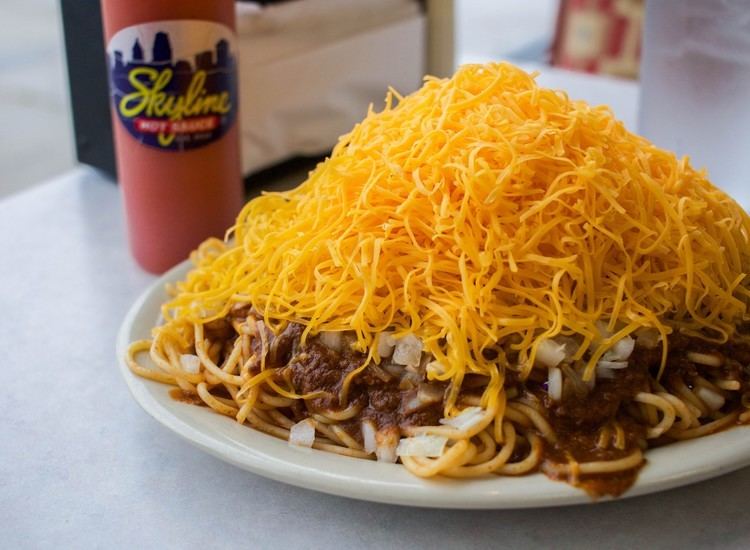Alternative names Cincinnati-style chili Place of origin United States | ||
 | ||
Similar | ||
Cincinnati chili (or Cincinnati-style chili) is a Mediterranean-spiced meat sauce used as a topping for spaghetti (a "two-way") or hot dogs ("coneys"), both dishes developed by Greek-Macedonian immigrant restaurateurs in the 1920s. Ingredients include ground beef, stock, tomato paste, cinnamon, other Mediterranean spices and sometimes chocolate in a soup-like consistency. Other toppings include cheese, onions, and beans; specific combinations of toppings are known as "ways". The name "Cincinnati chili" is often confusing to those unfamiliar with it, who expect the dish to be similar to chili con carne; as a result, it is common for those encountering it for the first time to conclude it is a poor example of chili.
Contents
- The melting pot cincinnati chili
- Origins and history
- Preparation and ordering
- The way system
- Misnomer
- Reception
- In popular culture
- Similar dishes
- References

While served in many local restaurants, it is most often associated with the over 250 "chili parlors", restaurants specializing in Cincinnati chili, found throughout greater Cincinnati with franchise locations throughout Ohio and in Kentucky, Indiana, and Florida. The dish is the area's best-known regional food.

The melting pot cincinnati chili
Origins and history

Cincinnati chili originated with immigrant restaurateurs from the Macedonian region who were trying to expand their customer base by moving beyond narrowly ethnic styles of cuisine. Tom and John Kiradjieff began serving a "stew with traditional Mediterranean spices" as a topping for hot dogs which they called "coneys" in 1922 at their hot dog stand located next to a burlesque theater called the Empress.Tom Kiradjieff used the sauce to modify a traditional Greek dish, speculated to have been pastitsio, moussaka or saltsa kima to come up with a dish he called chili spaghetti. He first developed a recipe calling for the spaghetti to be cooked in the chili but changed his method in response to customer requests and began serving the sauce as a topping, eventually adding grated cheese as a topping for both the chili spaghetti and the coneys, also in response to customer requests. To make ordering more efficient, the brothers created the "way" system of ordering. The style has since been copied and modified by many other restaurant proprietors, often fellow Greek-Macedonian immigrants who had worked at Empress restaurants before leaving to open their own chili parlors, often following the business model to the point of locating their restaurants adjacent to theaters.

Empress was the largest chili parlor chain in Cincinnati until 1949, when a former Empress employee and Greek immigrant, Nicholas Lambrinides, started Skyline Chili. In 1965, four brothers named Daoud, immigrants from Jordan, bought a restaurant called Hamburger Heaven from a former Empress employee, noticed the Cincinnati chili was outselling the hamburgers on their menu, and changed the restaurant's name to Gold Star Chili. As of 2015 Skyline (over 130 locations) and Gold Star (89 locations) were the largest Cincinnati chili parlor chains, while Empress had only two remaining locations, down from over a dozen during the chain's most successful period.

Besides Empress, Skyline, and Gold Star, there are also smaller chains such as Dixie Chili and Deli and numerous independents including the acclaimed Camp Washington Chili, probably the most well-known of the independents. Other independents include Pleasant Ridge Chili, Blue Ash Chili, Park Chili Parlor, Price Hill Chili, Chili Time, and the Blue Jay Restaurant, in all totalling more than 250 chili parlors. In addition to the chili parlors, some version of Cincinnati chili is commonly served at many local restaurants. Arnold's Bar and Grill, the oldest bar in the city, serves a vegetarian "Cincy Lentils" dish ordered in "ways". Melt Eclectic Cafe offers a vegan 3-way.

The history of Cincinnati chili shares many factors in common with the apparently independent but simultaneous development of the Coney Island hot dog in other areas of the United States. "Virtually all" were developed by Greek-Macedonian immigrants who passed through Ellis Island as they fled the fallout from the Balkan Wars in the first two decades of the twentieth century.
Preparation and ordering
Raw ground beef is crumbled in water and/or stock, tomato paste and seasonings are added, and the mixture is brought to a boil and then simmered for several hours to form a thin meat sauce. Many recipes call for an overnight chill in the refrigerator to allow for easy skimming of fat and to allow flavors to develop, then reheating to serve. Typical proportions are 2 pounds of ground beef to 4 cups of water and 6 oz tomato paste to make 8 servings.
The "way" system
Ordering Cincinnati chili is based on a specific ingredient series: chili, spaghetti, grated cheddar cheese, diced onions, and kidney beans. The number before the "way" of the chili determines which ingredients are included in each chili order. Customers order a:
Some restaurants, among them Skyline and Gold Star, do not use the term "four-way bean", instead using the term "four-way" to denote a three-way plus the customer's choice of onions or beans. Some restaurants may add extra ingredients to the "way" system; for example, Dixie Chili offers a "six-way", which adds chopped garlic to a five-way. "Ways" are traditionally served in a shallow oval bowl. Cincinnati chili is also used as a hot dog topping to make a "coney", a regional variation on the Coney Island chili dog, which is topped with grated cheddar cheese to make a "cheese coney". The standard coney also includes mustard and chopped onion. The "Three-way" and the "Cheese Coney" are the most popular orders and very few customers order a bowl of plain chili. Most chili parlors do not offer plain chili as a regular menu item. Oyster crackers are usually served with Cincinnati chili, and a mild hot sauce such as Tabasco is frequently used as an optional topping.
Misnomer
The name "Cincinnati chili" is often confusing to those unfamiliar with it because the term "chili" evokes the expectation of chili con carne, which it "bears no resemblance to." Cincinnati chili is a Mediterranean-spiced meat sauce for spaghetti or hot dogs and is very seldom eaten by the bowl as is typical with chili con carne. It is common for Cincinnatians to describe it starting with, "Well, it's not really chili..." Cincinnati chili is always seasoned with cinnamon, usually contains allspice and cloves, and often contains some combination of cumin, paprika, nutmeg, and/or chili pepper. Many copycat recipes call for a small amount of chocolate, but according to Dann Woellert, author of The Authentic History of Cincinnati Chili, "There is no chili parlor in Cincinnati that uses chocolate in its chili." It is normally of a thin consistency, closer to a soup than a stew, and contains no chunks of meat or vegetables, though it is common to find large pieces of cayenne pepper hulls in Empress chili. The consistency, seasonings, and serving method are more similar to pasta sauce or the spiced meat sauces used to top hot dogs in Rochester and other parts of Upstate New York, Rhode Island, and Michigan than they are to chili con carne.
Reception
Cincinnati chili is the area's "best known regional food". According to the Greater Cincinnati Convention and Visitors Bureau, Cincinnatians consume more than 2,000,000 lb (910,000 kg) of Cincinnati chili each year, topped by 850,000 lb (390,000 kg) of shredded cheddar cheese. Overall industry revenues were $250 million in 2014.
National food critics Jane and Michael Stern wrote, "As connoisseurs of blue-plate food, we consider Cincinnati chili one of America's quintessential meals" and "one of this nation's most distinctive regional plates of food". Huffington Post named it one of "15 Beloved Regional Dishes". In 2000, Camp Washington Chili won a James Beard Foundation America's Classics Award. In 2013, Smithsonian named Cincinnati chili one of "20 Most Iconic Foods in America", calling out Camp Washington Chili as their destination of choice. John McIntyre, writing in the Baltimore Sun, called it "the most perfect of fast foods", and, referring to the misnomer, opined that "if the Greeks who invented it nearly a century ago had called it something other than chili, the [chili] essentialists would be able to enjoy it". In 2015, Thrillist named it "the one food you must eat in Ohio."
It is common for those unfamiliar with it, confused by the misnomer and expecting chili con carne, to "scorn it" as a poor example of chili. Deadspin went so far as to call it "horrifying diarrhea sludge".
In popular culture
Country music duo Big & Rich sang about flying through Cincinnati and grabbing a bowl of Skyline chili in their song Comin' to Your City on the 2005 album of the same name. Blues musician Lonnie Mack sang a song called Camp Washington Chili on his 1986 album Second Sight.
Cincinnati chili is used allegorically as a symbol for vapid social interaction and social disconnection in the 2015 animated film Anomalisa, as the main character when on a business trip to Cincinnati is exhorted in multiple banal encounters to try the local specialty.
